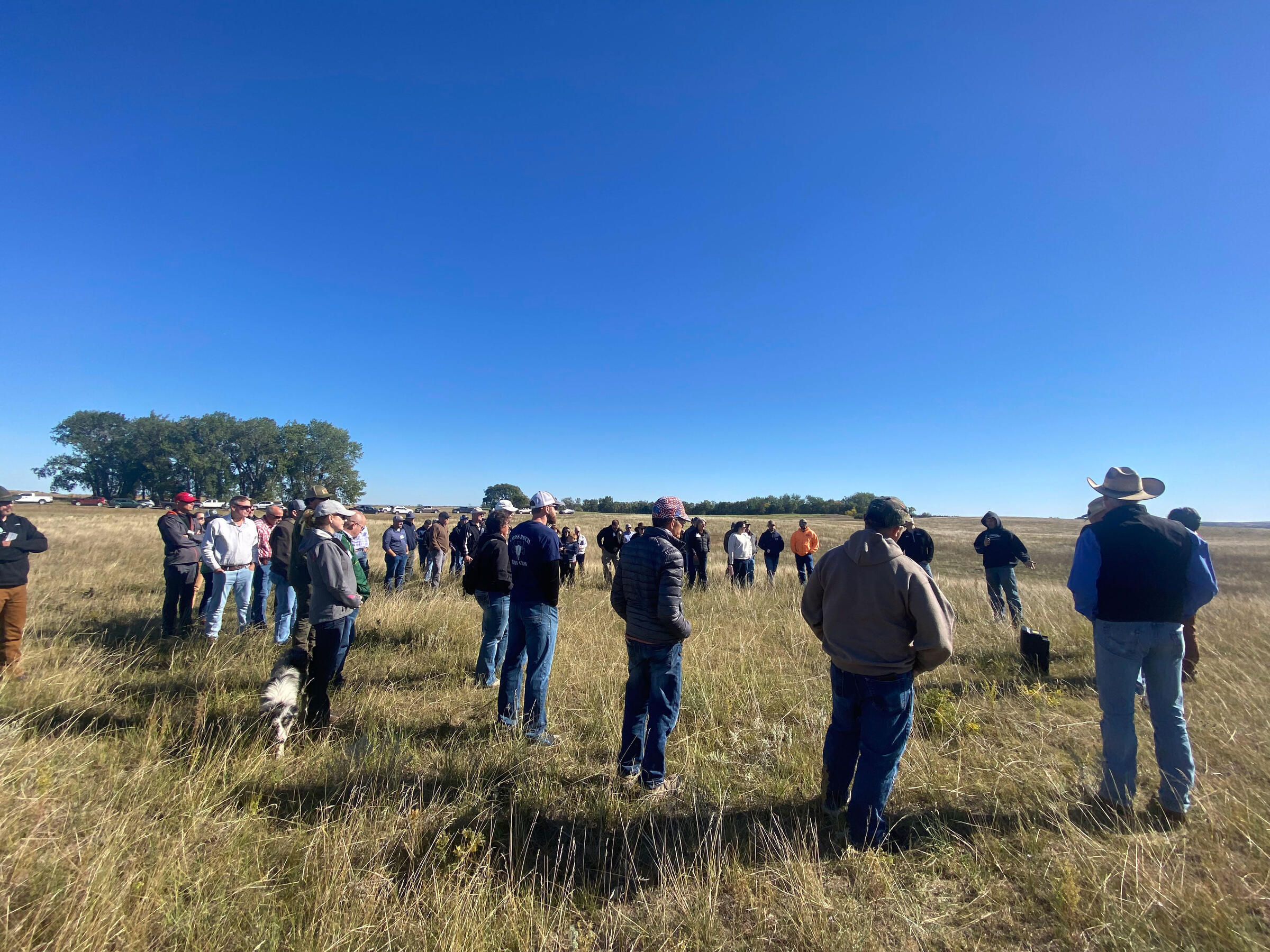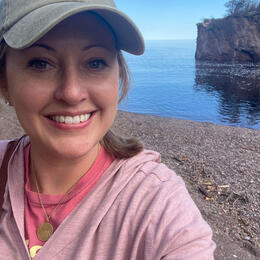As a conservation non-profit that focuses primarily on protecting bird habitat, we get to spend a lot of time outdoors and connected with our natural surroundings. It’s not uncommon for members of our team to pack binoculars and go birding, or to spend the day on a ranch while discussing habitat management with cattle grazing and meadowlarks singing in the background. For the curious, this could sound like an intriguing way to spend the day, for the conservationist this could sound like a professional development opportunity. For our Audubon Dakota team, it sounded like a mix of both and the perfect outreach and education opportunity.
In early March of 2022, Prairie Pothole Joint Venture invited our team to host events celebrating the Federal Duck Stamp Art Contest which was to be held at the Bismarck Heritage Center in September. Due to health concerns, the US Fish and Wildlife Service made the difficult decision to host the in person judging, virtually. Despite this change in contest planning, Audubon Dakota successfully hosted Grazing the Grasslands: A Wildlife and Ranch Tour at Black Leg Ranch, and Ducks at Daybreak: A Guided Birding Adventure. Both events gave us the opportunity to engage our community, educate on the importance of conservation, and nurture partnerships both regionally and nationally.
Engagement
First to engage our community, we invited families and partners of all ages to join us at one or both of our events. This was important because we wanted to integrate novice inquisitors with perceptive partners who wanted to ask questions, learn, and leave feeling connected with the environment and have a better understanding of Audubon’s conservation programs. Engaging attendees at each unique event was done by addressing our initiatives through in-person experiences.
Our first event, Grazing the Grasslands: A Wildlife and Ranch Tour, showcased Audubon Conservation Ranching (ACR) while being on an ACR ranch with cattle roaming nearby. Hosting a consecutive dinner at Black Leg’s Events Center, the Copper Jewell, allowed participants to experience beef from Audubon Certified bird-friendly land while learning how the program works. Guests enjoyed a meal of bison and beef burgers made from Black Leg Ranch Meats, sautéed vegetables, and homemade pickles from the Doan family garden. Presenters, Farley Green, Marketing Manager of ACR, and Anthony Hauck, Communications Manager of ACR explained the purpose of ACR, which is to stabilize the declining grassland bird populations in partnership with ranchers by focusing on three pillars: habitat management, animal health and welfare, and environmental sustainability. Farley highlighted that Audubon has enrolled 99 ranches in 15 states to impact 2.7 million acres of habitat.
And for our second event, Ducks at Daybreak: A Guided Birding Adventure, we took attendees birding with bird-guides at Atkinson Park, an Urban Woods and Prairies Nature Park (UWP), that we previously helped restore in partnership with Bismarck Parks District. We engaged our participants by illustrating the importance of supporting wildlife habitat in an urban setting while enjoying the sights and sounds of nature, and in our case the presence of a Bald Eagle, a Great Blue Heron, Mallards, and a Great Horned Owl. With over 15 people in attendance including two young children, we identified 19 species of birds, and shared about restoration at Atkinson Park while providing information on how people can get connected to and do more within their community.
Education
Next, hosting these two events allowed us to have the opportunity to educate our participants on various topics including conservation, easement properties, Duck Stamp dollars, and more. As we grazed grasslands at Black Leg Ranch with over 80 attendees, the Doan Family, owners and operators, shared their conservation legacy on the ranch. Jerry Doan highlighted the history of the land which has been in the family since 1882 and currently grazes Black Angus cattle through holistic management practices including utilizing cover crops and rotational grazing. Enrolled in Audubon’s Conservation Ranching Program, the Doan family continues to rejuvenate their land with cattle and birds in mind. Jayce Doan, a fifth-generation rancher, and son of Jay Doan, explained how rotational grazing mimics mother nature which improves productivity of land, returns nutrients to the soil, and improves forage production, which in-turn equals healthy cattle for consumers. By expanding their prairie habitat for grazing purposes, they have increased bird and wildlife populations for conservation and recreation purposes, all while improving the nutrients in the soil and contributing to supporting the environment for future generations to come.
For hunting and recreation on-site, Black Leg Ranch is home to Rolling Plains Outfitters, a guided hunting operation, ran by Jeremy Doan. Jeremy spoke about the various hunting tours on their property, including waterfowl hunting which requires all hunters to purchase the Federal Duck Stamp Permit. Our event, Grazing the Grasslands, happened to fall on the week of the North Dakota waterfowl season opener. This allowed a natural transition to our next speaker, Dave Azure, Wildlife Refuge Manager from U.S. Fish & Wildlife Service, to explain wetland and grassland easements and the benefit to waterfowl. Wetland easements in North Dakota for example, become rest stop areas for migrating waterfowl that need access to water, habitat, and forage. Dave noted that over the past 60 years, approximately 1.6 million acres of wetlands have been protected in the Prairie Pothole Region and that wetland easements restrict the rights to drain, burn, fill, and level protected wetland areas. Easements benefit wildlife by preserving open spaces for wildlife habitat.
To round out the night, keynote speaker and Executive Director of Audubon Great Plains, Kristal Stoner, began with an analogy of changing perspective when viewing non-native species, specifically stinging nettle, and viewpoint from her younger experiences being stung and seeing it as a vicious warrior plant ready for battle. Kristal explained that stinging nettle, a plant often viewed as one we should avoid, actually provides an array of nutritional benefits once cooked. Thinking of warriors, Kristal next introduced the Baird’s Sparrow, a harmless bird that relies on prairie habitat for survival and has seen a 2% decline every year for the past 50 years. Furthermore, Kristal highlighted the Western Meadowlark and Greater Prairie Chicken which are both facing decline. Grassland birds in general are facing the greatest decline, with 720 million having disappeared since 1970. Programs offered from Audubon help to address this decline, Kristal highlighted the North Dakota Conservation Forage Program, which seeks to return marginal cropland back to grasslands by offering financial assistance to landowners and producers. Touching base on some of the other Audubon Great Plains initiatives, Kristal addressed the importance of an urban-based strategy to restore and conserve riparian habitat through the Urban Woods and Prairies Initiative, and the resources available including prescribed fire planning, and technical assistance through the Prairie Management Toolbox. As she circled back to perspective of stinging nettles, she aimed to inspire the audience through notion that even the plant warriors have something wonderful to offer.
Partnerships
Lastly, hosting events in celebration of the Federal Duck Stamp Art Contest gave us the opportunity to nurture and collaborate with current partnerships, and build new ones. As a non-profit, our partnerships both regionally and nationally are crucial in helping us achieve our mission and we continue to be grateful for our network and continued partner support. For these events we worked with Prairie Pothole Joint Venture, the North Dakota Game and Fish Department, Black Leg Ranch, Bismarck-Mandan Bird Club, and the U.S. Fish and Wildlife Service. We would like to thank Prairie Pothole Joint Venture for sponsoring our two events and promoting it within their network. North Dakota Game and Fish Department collaborated with our team in planning and implementation of Grazing the Grasslands at Black Leg Ranch, including presenting on Duck Stamp Dollars from Casey Anderson, Wildlife Division Chief. Casey shared how the purchase of a duck stamp permit helps conservation with 98 percent of the purchase directly supporting conservation efforts to acquire and protect wetland habitat and purchase conservation easements for the National Wildlife Refuge System. He even showcased the first Duck Stamp permit which sold for $1.00 in 1934. To date, over $1.1 billion has been collected from Duck Stamp sales to the U.S. Fish and Wildlife Services Migratory Bird Conservation Fund which has protected over 6 million acres nationwide.
New partnerships came in the form of relationships formed on individual levels through conversation and connections cultivated around each event. To promote the Federal Duck Stamp Art Contest, the National Audubon Society team worked with U.S. Fish and Wildlife Service, organizers of the Federal Duck Stamp Art Contest, and created a video promotion about the importance of the Duck Stamp from Dr. Elizabeth Gray, Chief Executive Officer of the National Audubon Society.
Bird-guides Seth Owens and Adam Ryba, were invited to participate after connections made prior to the birding walk. Seth, an avid wildlife photographer and Education and Outreach Coordinator for Pheasants Forever-ND, brought years of birding knowledge and excitement as a bird guide to the early, chilly, Friday morning. Adam, Biologists at USFWS-ND Ecological Services Field Office, brought an enthusiastic interest in finding unique species and shared his experience birding with the group. These two avid birders that we now get to call colleauges, shared in conversation about why the enjoy connecting with nature both professionally and personally, and specifically through birding. This gave attendees an opportunity to consider the enjoyment for those who aren't self-proclaimed birders, and our hope is they will pick up a new hobby.
As a final reflection on the success of September's events, our office collectively feels appreciation in the work we do, the people we meet, and the relationshiops we build. Events like these are a reminder that our work matters and is making a difference for people and wildlife.










